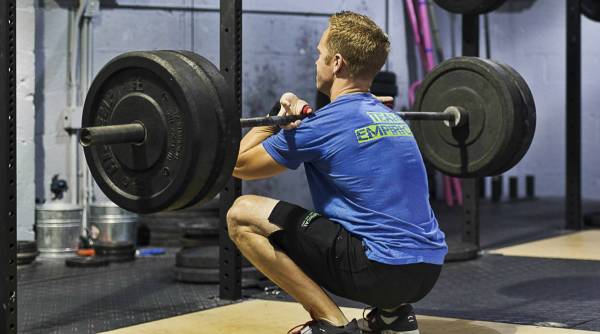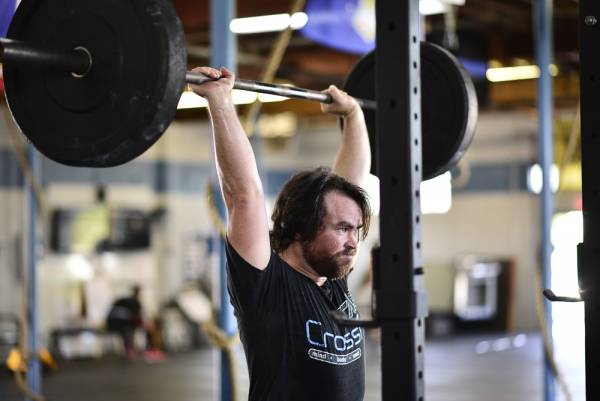If you’ve read anything about building muscle on the Internet or talked to the suspiciously jacked dude at your gym, you’ve undoubtedly been told that all you need to do is “add weight to the bar.”
What this kind of advice is referring to is something called “the overload principle.” This principle dictates that muscles experience overload when exposed to a stimulus greater than they are normally accustomed to, and that such an overload is necessary for new muscle growth (or any desired adaptation)2.
Makes sense, right? Unless you give your muscles a reason to grow by exposing them to new stimulus, they ain’t gonna grow. It also makes sense that the simplest, most measurable way to apply progressive overload is by lifting more weight. If you bench press 205lb for 5 reps today, and you are able to bench press 210lb for 5 reps next week, you apply the overload principle and expose your muscles to new stimulus, thus creating an environment conducive to muscle hypertrophy.
Easy enough. Focus on increasing the weight you lift as often as possible and you’re well on your way to hypertrophy heaven, right? Well…maybe not.
When Adding Weight to the Bar Fails
There’s a saying that “nothing in life is certain except death and taxes.” And while that may be true, there’s one other “certainty” they forgot to mention: strength plateaus.
It’s true. At some point your ability to add weight to your lifts on any kind of consistent basis will stall. If you’re relatively new to the iron game, you’re probably all, “Yeah right bro, not for me.” Learn soon you will, young musclehead. For the rest of you who have been at this for a while, the idea that you will hit plateaus in your ability to add weight to your lifts – sometimes for weeks, or even months, at a time – probably rings (agonizingly) true.
So when your go-to “add weight to the bar” approach for progressive overload fails (and it will fail) what are you gonna do? Give up on building muscle? Start running marathons and wearing those short shorts?
You could. Or, you could accept that adding weight to the bar is only one way to apply progressive overload and start focusing on the other ways as well.
Don’t think strength plateaus will happen to you? Think again.
Lifting More Weight Is Only One Tool
Not only is adding weight to the bar just one of the ways to apply progressive overload, it may not even be the best way to do it. I’m not going to argue that increasing the weight as often as possible is a bad idea. It’s actually a great idea. But too many people adopt an “at-all-costs” mentality, and doing that can actually hurt your muscle gains.
Here’s what I mean: adding weight to your lifts is great, but not if you do so at the cost of working the target muscles. Lifting five more pounds than you did a week ago is awesome. But if you have to sacrifice form and muscle tension in order to do so, it probably isn’t going to help out a lot in terms of increased muscle.
Instead of continuing to grind away, trying to find some way to add weight to your lifts, start to focus on the other forms of progressive overload: doing better work or improving training density.
Do Better Work
Doing ‘better’ work is about maximizing muscular tension and mastering technique. Let’s say you don’t add any weight to the bar, but you do a better job of placing tension on the target muscle through the entire range of motion. Does that mean you applied progressive overload? You betcha. As fellow Breaking Muscle contributor Luke Briggs said in a recent article, “…your body doesn’t know how much weight you’re lifting. All it knows is the amount of tension it feels.”
When using better work as a form of progressive overload, you focus less on just moving a weight from point A to point B, and more on how you move the weight. Brad Schoenfeld describes this as “mechanical tension,”1 and attributes this as one of the three primary factors associated with muscle growth.
Here’s how to apply the ‘better work’ approach to your workouts:
- Stop worrying about moving maximum weight and instead focus on creating maximum tension in the target muscle.
- Worry less about reps. Research suggests that the best rep ranges for hypertrophy are 6-12, so your goal is to perform sets that fall somewhere within that range. Pick a weight that you can get 8-10 reps with and do as many as you can while maximizing muscular tension.
- Slow down. Control the weight through the entire range of motion. Pause at the top and the bottom of the movement and actively ‘flex’ the target muscles.
- Aim to ‘perfect’ the movement a little bit from workout to workout, improving your ability to maximally target and create tension in the working muscle.

Changing your focus from the weight to the quality of your reps is a subtle way to induce progressive overload.
Improve Training Density
Doing more work in less time – increasing your training density – is not a new concept in the fitness realm. However, density is often relegated to the fat loss sector, when in fact, it can also be beneficial for building muscle. If you can vary the training stimulus by increasing training density, you effectively satisfy the Overload Principle.
Training density addresses the “volume” and “duration” factors of fitness:
- Volume is your total workload, or how many sets and reps you perform in a given workout. (Generally, sets x reps.)
- Duration is the length of time your workout lasts.
- Training Density is the combination of the two – how much work you do in given time frame.
Traditionally, there are two ways to improve density:
- Perform the same workload in less time.
- Perform more work in the same amount of time.
Two examples of training density application:
- Perform 100 push ups as fast as possible. Record your time and try to beat that time from week to week.
- Perform as many push ups and pull ups (alternating back and forth) as you can in 5 minutes. Record how many reps you complete and aim do more reps from week to week.
I prefer to perform density training at the end of workouts. It creates significant fatigue that would make doing anything else at a high level difficult if performed earlier in a workout.
The trick to using density training as a means of muscle growth is to make sure you select the appropriate training modalities. You can’t just improve density; you need to do so within the realms of what contributes to hypertrophy. For example, you’d want to select an approach that allows most of your work (reps) to occur within a range that is known to produce muscle growth: the 6-12 range. Using the examples from above, most people who train consistently will end up performing reps that fall within the 6-12 range with those exercises.
You may do more than 12 reps for push ups at the beginning of the density block, but towards the end as fatigue sets in, you will likely fall somewhere back into the 6-12 rep range. Similarly, with pull ups, you may end up doing sets of less than 6 reps toward the end of the density block. Variation like this is fine, as long as the majority of the work falls within the 6-12 rep range.
If bodyweight exercises are too difficult, you can always use external resistance (dumbbells, barbells, cables/bands, etc.). Select exercises and a resistance that will allow you to perform most of the work in the 6-12 rep range.
Continue to Page 2 for a 4-Week Plan for Progressive Overload
A 4-Week Plan for Progressive Overload
The program laid out below is based on the principles you learned above. There’s more than one way to apply progressive overload and create the stimulus for hypertrophy, and applying various methods of overload in your workouts creates the best opportunity for muscle growth.
Within each of the workouts below, you will find three distinct training blocks, distinguished by the focused type of progression. Focusing on each aspect of progressive overload will facilitate improved markers of fitness, including strength, hypertrophy, and conditioning.
- Training Block 1: Increased load (lift heavier weight or lift the same weight for more reps)
- Training Block 2: Better work (create more tension in target muscles/master the movement)
- Training Block 3: Improve density (Perform the same workload in less time, or perform more work in the same amount of time)
You may not improve in every area, each week. But you should be able to progress in some way each time you set foot in the gym (i.e. improvement in one of the three forms of progression). The result is a workout program that will not only help you get jacked, but will also improve overall strength and conditioning.

Who doesn’t want a program that can help you progress every time you set foot in the gym?
The Nuts and Bolts
The sample training program below can be followed for four weeks, as long as you keep progressing in some way during each workout. After 4-6 weeks, you could keep following this same workout structure, but introduce new exercises and/or mix up the reps performed.
During this training plan, you will be training three times per week. Which days you choose to train is up to you, although it would be beneficial to separate each workout with at least one day of rest.
The set notation is sets x reps @ rest, in seconds. So when you see this:
- Incline Bench Press 3 x 6-8 @ 120
It means this:
- 3 sets of 6-8 reps with 120 seconds of rest in between sets.
When you see an a., b., etc., do these as supersets. Unlike many supersets you may have done in the past, you still take the programmed rest period between opposing movements.
Workout A
1. Incline Bench Press 3 x 6-8 @ 120
2. Pull Ups 4 x 8-12 @ 120
3a. Flat Dumbbell (DB) Press 4 x 8-12 @ 60
3b. DB Shrug w/ 2 second ISO hold at top 4 x 8-12 @ 60
4a. DB Curl 4 x 15 @ 60
4b. Triceps Push Down 4 x 15 @ 60
5. Barbell Complex (bent rows, hang cleans, push press, front squat): Perform 8 reps of each exercise, resting as needed. Complete as many rounds as possible in 6 minutes.
Workout B
1. Deadlift (trap bar or straight bar) 2 x 6-8 @ 120
2. Reverse Lunge 4 x 10-12 @ 60
3. Dumbbell/Kettlebell Goblet Squat 4 x 10-12 @ 60
3a. Hip Thrust 4 x 15 @ 60
3b. Plank 4 x 30-60 seconds @ 60
4. Timed one-mile run. You can do this on a treadmill, outside, etc. Complete the distance in the least amount of time possible.
Workout C
1. DB 1-arm Clean & Press 3 x 6-8 @ 120
2. Seated Cable Row 4 x 8-12 @ 120
3. DB Lateral Raise 4 x 8-12 @ 90
4a. DB Hammer Curl 4 x 10 @ 60
4b. Lying DB Triceps Extensions 4 x 10 @ 60
5. 100 push ups as fast as possible. Record the time it took you to complete the 100 push ups.

Running? In a hypertrophy program? You betcha.
Work Better and Improve Density to Beat Plateaus
Adding weight to the bar is great, as long as you’re doing so in the context of proper technique and prioritizing muscular tension. Run that for as long as you can. But when it stops happening on a regular basis, find another way to progress and increase the training stimulus by doing better work or trying to improve training density.
The best part of all this? If you’ve been grinding away and trying to add weight to your lifts for a while, switching things up and focusing on muscular tension and improving density often leads to a more interesting training experience and a surge in results. Who doesn’t want to try something that provides that?
More Ways to Shatter Your Strength Plateaus
- CrossFitters: Stuck in a Strength Rut? Implement These Strategies
- Cal-Poly’s 8-Week Deadlift Program: Push Through a Strength Plateau
- 7 Ways for Experienced Lifters to Stimulate Muscle Growth
- New on Breaking Muscle Today
Photos courtesy of CrossFit Empirical.
References
1. Schoenfeld, Brad J. “The Mechanisms of Muscle Hypertrophy and Their Application to Resistance Training.” Journal of Strength and Conditioning Research 24 (2010): 2857-872.
2. Baechle, Thomas R. Essentials of Strength Training and Conditioning. 3rd ed. Champaign, IL: Human Kinetics, 2008.






